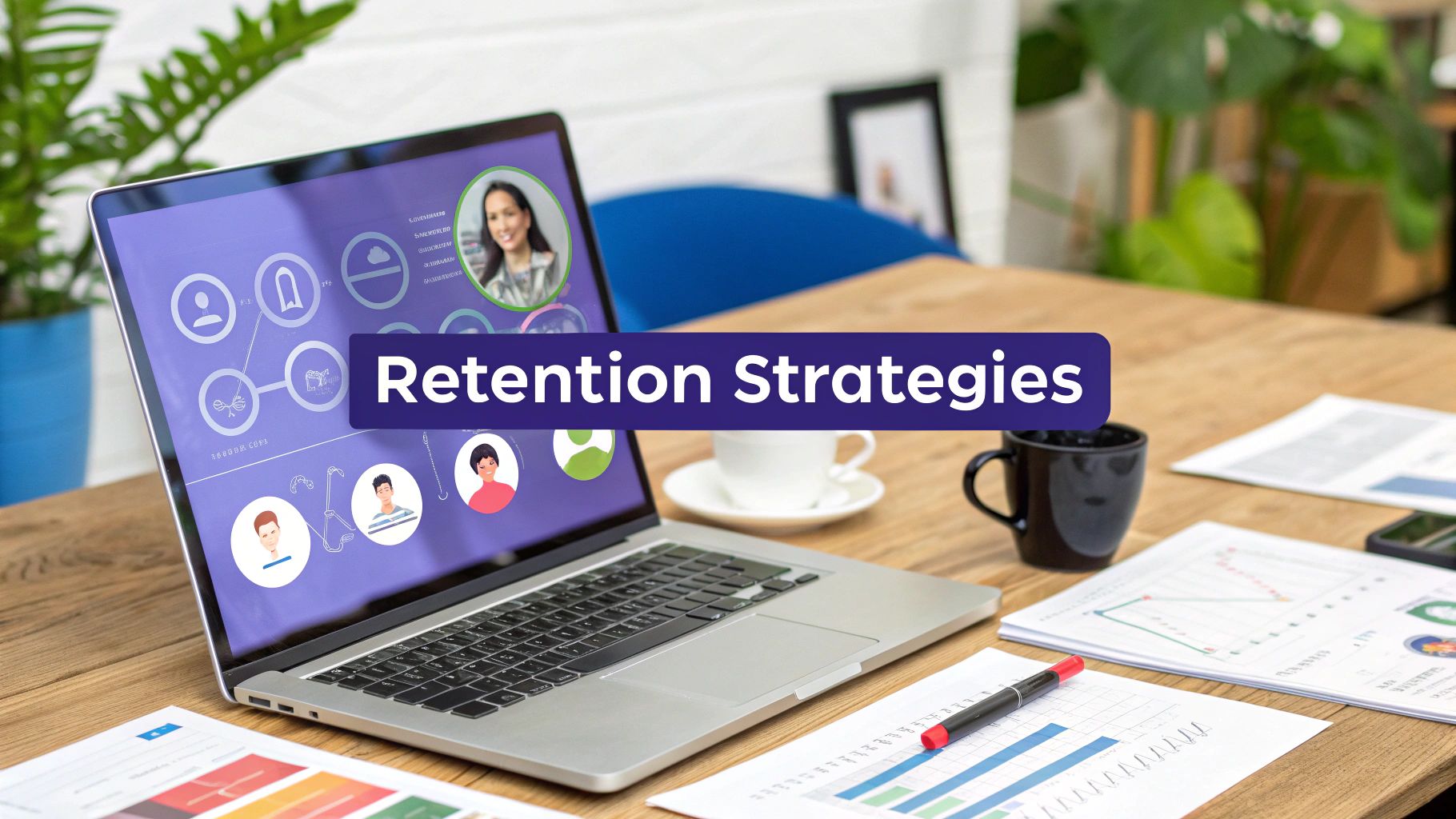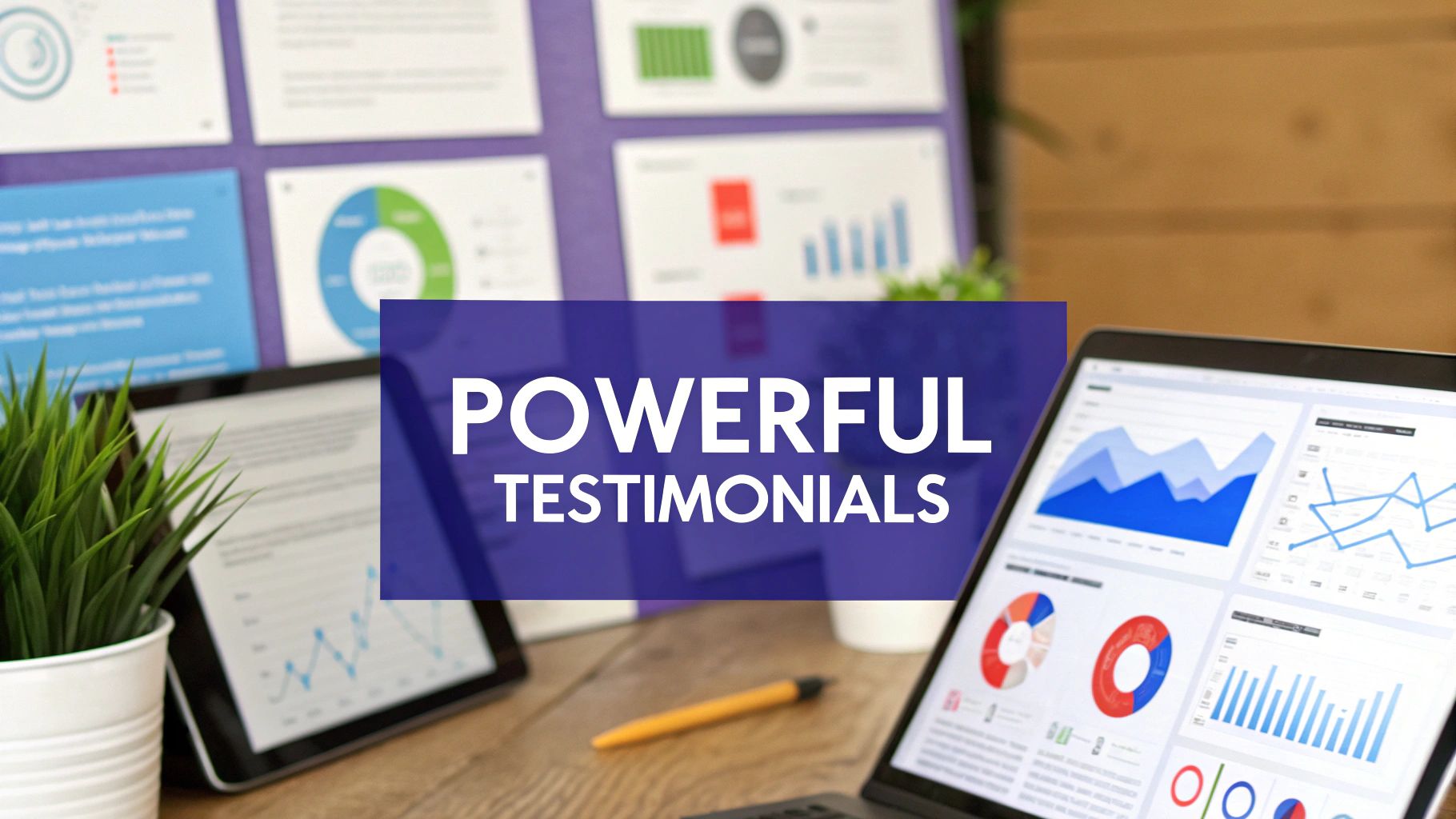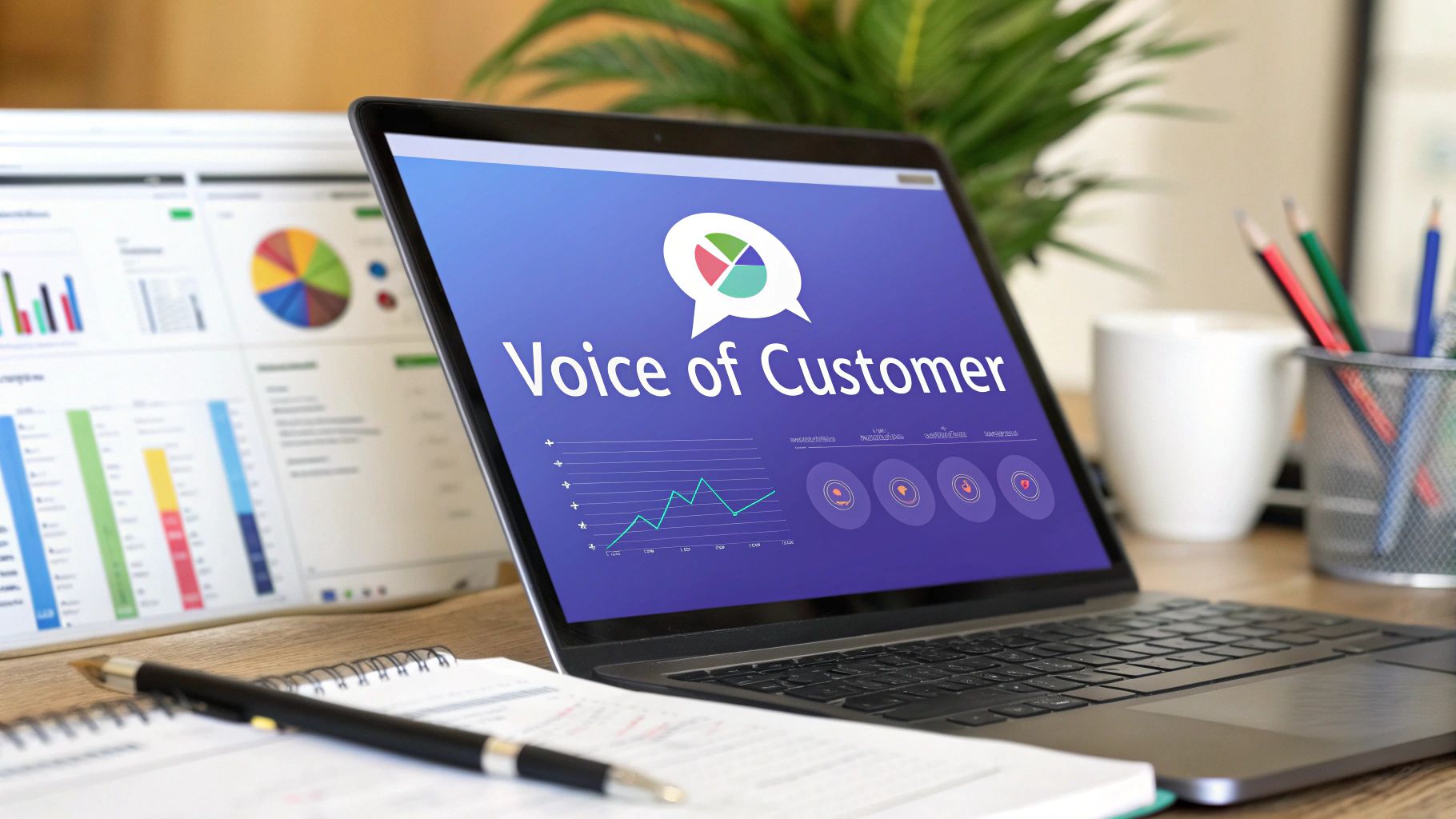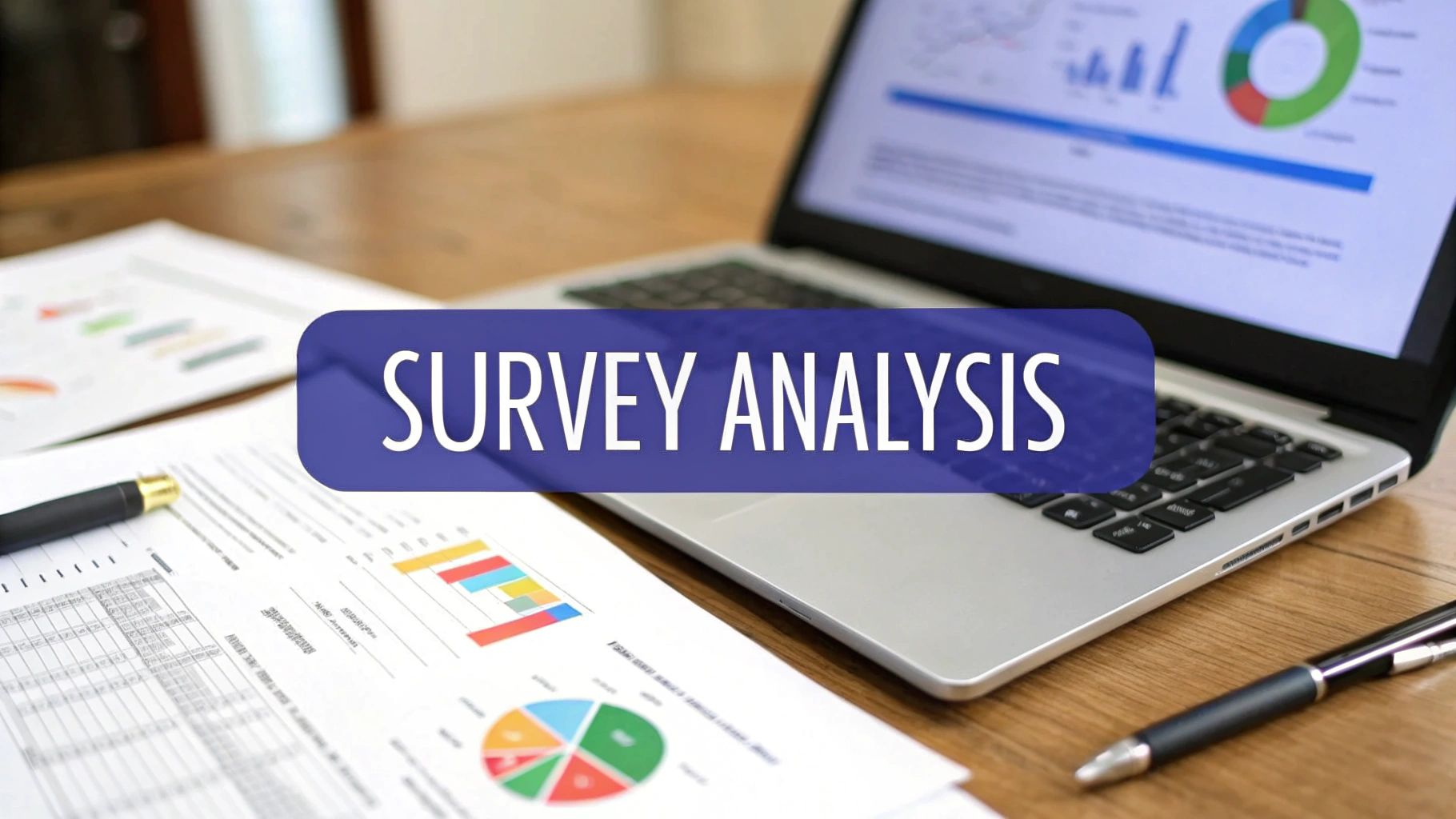Top SaaS Customer Retention Strategies to Boost Your Business
Learn essential SaaS customer retention strategies to reduce churn, improve engagement, and grow your customer lifetime value. Discover proven tactics now.

Getting new customers is exciting, but keeping the ones you have is what builds a lasting SaaS business. High churn rates can silently sink even the most promising products. The problem is, many companies focus heavily on acquisition and only think about retention when a customer is already walking out the door. A better approach is to build retention into your entire customer experience, from the first login to their hundredth renewal.
A focus on retention directly affects your bottom line. Loyal customers spend more over time and become advocates for your brand, lowering your customer acquisition costs. This is basic to sustainable growth, and knowing the financial effect is key. For more on this, check out this guide on how to calculate and increase this important metric: A Guide to Improving Customer Lifetime Value.
This guide breaks down eight specific, actionable SaaS customer retention strategies you can implement immediately. We will cover everything from proactive onboarding and value-driven education to building a community that customers will not want to leave. Each strategy is designed to deliver consistent value, solve real problems, and make your product indispensable to your users' success.
1. Proactive Customer Onboarding Programs
The first interaction a new user has with your product sets the tone for the entire relationship. A proactive customer onboarding program is one of the most effective SaaS customer retention strategies because it guides users to their "aha moment" quickly. This structured process shows new customers how to achieve their goals, reducing initial friction and demonstrating your product's value from day one.
A successful onboarding experience builds confidence. For instance, Canva uses interactive tutorials to help users create their first design in minutes, providing an immediate sense of accomplishment. Similarly, Notion's template gallery allows users to bypass the blank-slate problem by starting with proven, pre-built workflows. A strong onboarding program is important, and knowing why client onboarding is key to SaaS startups' success reinforces its importance.
How to Implement a Proactive Onboarding Program
- Map the Customer Journey: Identify the key actions a user must take to realize value. Optimize your onboarding to guide them through these milestones.
- Use Progressive Disclosure: Introduce features gradually. Start with the core functionality and reveal more advanced options as users become more proficient.
- Automate Trigger-Based Communication: Send targeted emails or in-app messages when users complete key actions or, more importantly, when they become inactive during the onboarding phase.
The following visual summary highlights the key metrics to track when evaluating the effectiveness of your onboarding program.
Tracking these metrics gives you a clear picture of how quickly users find value and whether they are sticking around as a result. For a closer look into building your process, explore these detailed customer onboarding strategies.
2. Usage-Based Health Scoring and Proactive Interventions
A proactive approach to retention means identifying at-risk customers before they decide to leave. Usage-based health scoring is one of the most powerful SaaS customer retention strategies because it provides a data-driven system to monitor engagement and predict churn. This method assigns a "health score" to each account by tracking product usage, feature adoption, and support interactions, allowing teams to intervene with precision when a customer shows signs of disengagement.

A strong health scoring model turns your customer success team from reactive firefighters into proactive advisors. For example, Gainsight and Totango built their platforms around this concept, helping companies visualize account health and automate outreach. Similarly, Intercom uses behavioral triggers to send in-app messages when a user's activity drops, guiding them back to valuable features. This predictive capability allows you to save accounts that might otherwise silently churn.
How to Implement Usage-Based Health Scoring
- Start with Key Metrics: Begin by tracking 3-5 core metrics that signal value realization, such as daily active users, key feature adoption, or session duration. Avoid overcomplicating the model at first.
- Combine Data Sources: Integrate product analytics (e.g., Mixpanel) with relationship data like NPS scores, support ticket frequency, and payment history for a complete view of customer health.
- Create Intervention Playbooks: Define clear, actionable steps for your team to take based on health score changes. For example, a "yellow" score might trigger an email check-in, while a "red" score prompts a direct call.
- Validate and Refine: Regularly review your scoring model against actual churn data to confirm its accuracy. Adjust the weights of different metrics to improve its predictive power over time.
By systematically tracking and acting on these health scores, you can create targeted retention campaigns that address specific customer needs. For a more complete overview, you can discover more about building a customer health score and its components.
3. Value-Driven Customer Education Programs
Beyond just fixing problems, a powerful way to retain customers is to help them become experts with your product. Value-driven customer education programs are complete initiatives that teach users how to maximize the benefits of your software. This approach turns users from passive consumers into active, skilled advocates who see your tool as indispensable to their success.
Effective education shows a company’s investment in its customers' growth. For example, HubSpot Academy offers free certifications that have created millions of certified marketing and sales professionals who champion its platform. Similarly, Salesforce Trailhead uses gamification with badges and points to make learning its complex ecosystem fun and engaging for millions of learners. These programs are among the best saas customer retention strategies because they build solid product loyalty and user competence.
How to Implement a Value-Driven Education Program
- Create Quick-Win Content: Start with short, digestible videos (5-10 minutes) or tutorials that address common pain points. High completion rates on these initial pieces build momentum for more in-depth learning.
- Use Gamification Elements: Integrate badges, points, and leaderboards to motivate users and create a sense of accomplishment. This turns education from a chore into a rewarding experience.
- Tie Education to User Health: Monitor learning milestones and correlate them with customer health scores. Proactively offer educational resources to users whose engagement is dropping to help them rediscover value.
- Identify and Fill Knowledge Gaps: Regularly survey your user base to find out what they struggle with or what they want to learn next. Use this direct feedback to guide your content creation strategy.
4. Continuous Value Communication and ROI Demonstration
Your product might deliver incredible results, but if customers do not recognize that value, they are less likely to renew. Continuous value communication is a vital SaaS customer retention strategy that involves regularly showing customers the tangible return on investment (ROI) they get from your product. This proactive approach makes your product’s impact visible and justifies its continued cost, especially during renewal discussions with economic buyers.
A successful value demonstration connects product usage to business outcomes. For example, Grammarly sends weekly writing reports that quantify improvements and time saved, directly showing personal productivity gains. Similarly, Gong.io proves its worth by helping sales teams correlate insights from recorded calls with an increase in closed deals, making a clear case for its business impact. Communicating this value is a core principle for any customer-focused organization, as explained in resources covering B2B customer retention strategies.
How to Implement Continuous Value Communication
- Automate Value Reports: Create and send automated reports or in-app dashboards that highlight key metrics. This provides consistent communication without placing a heavy burden on your customer success team.
- Schedule Quarterly Business Reviews (QBRs): Hold strategic meetings with key stakeholders 90-120 days before renewal. Use this time to review historical performance, align on future goals, and address any potential concerns.
- Focus on Buyer-Centric Metrics: While end-users might care about feature usage, decision-makers focus on business outcomes like cost savings, revenue generated, or efficiency improvements. Adjust your reports to reflect these priorities.
The following video from Gainsight, a leader in the customer success space, offers more information on structuring and executing effective Quarterly Business Reviews to show value.
5. Strategic Product Roadmap Transparency and Customer Co-Creation
Engaging customers directly in your product's evolution is a powerful SaaS customer retention strategy. By sharing your product roadmap and inviting users into the development process, you turn them from passive subscribers into active partners. This approach makes customers feel heard and valued, creating a strong emotional investment in your product's future and making sure it evolves to meet their real-world needs.
This level of transparency builds exceptional loyalty. Trello, for example, famously uses a public Trello board to display its roadmap, allowing users to see and vote on upcoming features. Similarly, Notion has cultivated a devoted community by running active beta programs and maintaining open communication about its development priorities. When customers see their feedback directly influence the product, their connection to your brand grows significantly.
How to Implement Roadmap Transparency and Co-Creation
- Systematize Feedback Collection: Use dedicated tools like Canny or ProductBoard to organize feature requests. This prevents valuable insights from getting lost and makes it easy to spot popular ideas.
- Close the Feedback Loop: When you ship a feature that a customer requested, notify them personally. This simple action shows that you are listening and reinforces their positive behavior.
- Create Customer Advisory Boards: Form a small group of your most strategic and engaged customers. Meet with them regularly to discuss high-level strategy and get their input on major product decisions.
- Highlight Customer-Inspired Features: In your release notes and product updates, make a point to celebrate features that came directly from user suggestions. This encourages more users to participate in the feedback process.
Sharing your development plans builds trust and helps your product remain indispensable to your users. For those looking to structure their planning process, learning how to create a product roadmap is a foundational first step.
6. Flexible Pricing and Downgrade Prevention Strategies
Rigid pricing models can force customers to churn when their needs or budgets change. Implementing flexible pricing and downgrade prevention is one of the most practical SaaS customer retention strategies because it provides alternatives to outright cancellation. This approach acknowledges that customer value fluctuates and builds a relationship that can weather financial shifts, seasonal demands, or changes in business focus.
A flexible model retains revenue that would otherwise be lost and keeps the user within your ecosystem, opening the door for future expansion. For instance, Adobe Creative Cloud offers monthly plans that can be scaled up or down, allowing freelancers to adjust costs based on their project pipeline. Similarly, Zoom’s freemium model serves as a natural downgrade path, keeping users on the platform even if they no longer need paid features. A well-designed pricing structure creates pathways to stay, not just reasons to leave.
How to Implement Flexible Pricing and Downgrade Prevention
- Create a "Pause" Option: Allow customers, especially seasonal businesses, to pause their subscription for 1-3 months. This retains their account, data, and the relationship without forcing them to cancel and later re-onboard.
- Offer Strategic Downgrades: Design tier structures with clear value differentiation. When a customer attempts to cancel, use the conversation or an automated flow to offer a downgrade to a more suitable plan that still meets their core needs.
- Implement Usage-Based Models: For products where consumption varies, like AWS, a pay-as-you-go model perfectly aligns cost with value. This model inherently adjusts to the customer’s business cycle, reducing the need for plan changes.
The following visual summary highlights key metrics to track when evaluating the effectiveness of your pricing flexibility.
Tracking these metrics helps you follow customer growth trajectories and the long-term value of retaining users on lower-tier plans. To explore this topic further, consider the information on value-based pricing from specialists like Patrick Campbell.
7. Community Building and Peer Network Effects
Your product might solve a customer's problem, but a vibrant community gives them a reason to stay invested emotionally and professionally. Building a community is one of the most powerful SaaS customer retention strategies because it creates value beyond your software's features. It changes your user base from a collection of individual accounts into a connected ecosystem where customers help each other, share best practices, and build valuable professional networks.
This approach generates a powerful retention loop. Salesforce’s Trailblazer Community, for example, connects millions of users for learning and networking, making a user's expertise in Salesforce a valuable career asset. Similarly, Figma’s community allows users to share templates and plugins, creating an ecosystem that adds immense value and makes switching to a competitor far less appealing. A strong community makes your product the center of a professional identity, not just another tool.
How to Implement Community Building
- Start with Super-Users: Identify and support your most passionate customers first. Create a small, invite-only group for them to connect, share feedback, and act as brand advocates before you open the community to everyone.
- Establish Clear Guidelines and Moderation: From day one, set clear rules for engagement and have an active moderation plan. A safe and constructive environment is basic for a healthy community.
- Recognize and Reward Top Contributors: Acknowledge your most helpful members with exclusive access, swag, or ambassador titles. This encourages continued participation and sets a positive example for others.
- Host Regular Engagement Events: Keep the community active by organizing events like AMAs with your team, user-led workshops, or design challenges. Consistent programming gives members a reason to return.
8. Personalized In-App Engagement and Feature Adoption Campaigns
Many users only scratch the surface of what your product can do, which limits the value they receive. Personalized in-app engagement is a powerful SaaS customer retention strategy that uses behavioral data to guide customers to high-value features they might otherwise miss. By delivering targeted messages, tooltips, and prompts at the right moment, you can drive deeper product adoption and increase stickiness.
This approach creates compounding value by turning passive users into power users. For example, Airtable guides users to automations and advanced views once their data structure becomes complex enough to benefit from them. Similarly, Dropbox uses subtle in-app nudges to encourage users to try folder-sharing and collaboration features, changing it from a personal storage tool into a team hub. These targeted campaigns make the product more integral to the user's workflow.
How to Implement Personalized In-App Engagement
- Segment Audiences Carefully: Different user types need different feature recommendations. Base your segments on behavior, user role, or subscription tier to deliver relevant guidance.
- Tie Messages to User Behavior: Trigger prompts based on specific actions or milestones. A message about a new reporting feature is more effective after a user exports their first dataset.
- Focus on High-Impact Features: Analyze your data to identify which features correlate most strongly with long-term retention and expansion. Prioritize campaigns that drive adoption of these key capabilities.
- Respect User Attention: Limit the frequency of your messages to avoid notification fatigue. Always make prompts easy to dismiss and consider adding a "remind me later" option.
SaaS Customer Retention Strategies Comparison
Start Building a Stronger Retention Program Today
You now have a collection of eight powerful SaaS customer retention strategies, from foundational onboarding programs to advanced community-building initiatives. The common thread connecting them all is a relentless focus on the customer's success. Retention is the outcome of a company-wide commitment to delivering and communicating value at every stage of the customer journey.
A successful retention program does not happen by accident. It is built by systematically implementing interconnected tactics. Think of it less as a checklist and more as a system where proactive interventions, value-driven education, and transparent communication work together. This creates a customer experience that solves a problem and also makes users feel understood and invested in your product's future.
Your Actionable Next Steps
Instead of trying to implement all eight ideas at once, focus on what will make the most immediate impact. Here’s a simple way to begin:
- Identify Your Biggest Leak: Where are you losing the most customers? Is it in the first 30 days, or after six months? Use customer exit surveys and analytics to find your primary churn driver.
- Pick One or Two Strategies: If early churn is the issue, start with revamping your proactive customer onboarding. If veteran users are leaving, focus on continuous value communication or strategic roadmap co-creation to reignite their engagement.
- Measure and Iterate: Whichever strategy you choose, set clear metrics for success. Track churn rate, Net Promoter Score (NPS), and product adoption for that user segment. Use the data to refine your approach and prove its effectiveness.
Mastering these SaaS customer retention strategies is about more than just reducing churn. It’s about building a sustainable, profitable business fueled by happy, successful customers. By moving from a reactive to a proactive mindset, you change your customer relationships from simple transactions into long-term partnerships. This creates a powerful flywheel of loyalty, advocacy, and organic growth that will set your SaaS business apart.
Ready to find out exactly why your customers are leaving and what you can do about it? Surva.ai provides intelligent exit surveys and churn deflection flows to help you gather critical feedback and present personalized offers to retain at-risk users. Stop guessing and start building better retention strategies today at Surva.ai.


